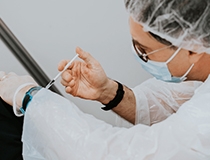Stem cell therapy is a revolutionary field of regenerative medicine that gives hope and healing to individuals suffering from various medical conditions. But, how does this remarkable therapy work, and what are the diverse treatments it offers?
This blog will delve into stem cell therapy's fundamental principles to shed light on this miraculous procedure. Moreover, we will also discuss the available treatments, from addressing blood-related disorders to revitalizing musculoskeletal health and even tackling neurological challenges.
Keep reading to understand the remarkable workings of stem cell treatment and the myriad possibilities it holds for the future of medicine.
How Stem Cell Therapy Works
Stem cell therapy is a highly advanced medical procedure that utilizes the exceptional regenerative properties of stem cells to facilitate healing in the human body. Correctly understanding the complexities involved in this treatment is crucial to fully comprehend its revolutionary impact on modern medicine.
Here's a simple breakdown of how stem cell treatment procedures are performed:
Patient Evaluation
A thorough evaluation of the patient's medical history and current health condition is conducted before the procedure. This helps doctors determine if stem cell therapy is a suitable option and which type of stem cells should be used.
Stem Cell Source Selection
Depending on the condition, stem cells can be obtained from various sources, including:
- Autologous: Stem cells are harvested from the patient's body, often from bone marrow or adipose (fat) tissue.
- Allogeneic: Stem cells are obtained from a donor, typically from another person's bone marrow.
Stem Cell Collection
If using autologous stem cells, the patient may undergo a procedure to collect the stem cells. For example, bone marrow is typically collected from the hip bone using a needle. On the other hand, if allogeneic stem cells are used, the stem cells are obtained from a donor and prepared for transplantation.
Stem Cell Isolation and Processing
The collected stem cells are then processed in a laboratory to isolate and concentrate them. This may involve filtering, centrifugation or other techniques to obtain a high concentration of cells.
Stem Cell Administration
The prepared stem cells are administered to the patient. The method of administration can vary:
- Injection: Stem cells may be injected directly into the affected area, such as a joint for arthritis treatment or the spinal cord for spinal cord injury.
- Intravenous (IV) Infusion: Stem cells can be infused into the bloodstream, allowing them to circulate throughout the body and reach various target tissues.
- Surgical Implantation: In some cases, stem cells are implanted during surgery, such as in the case of heart disease or certain neurological conditions.
Monitoring and Follow-Up
After the stem cell administration, patients are closely monitored for any complications or adverse reactions. Follow-up appointments and tests are scheduled to assess the treatment's effectiveness and the patient's overall condition.
Recovery and Rehabilitation
Depending on the condition being treated, patients may need a period of recovery and rehabilitation. This could involve physical therapy, lifestyle modifications or other interventions to support the healing process. Patients often also have long-term follow-up care to assess the durability of the treatment's effects and ensure there are no delayed complications.
Available Stem Cell Treatments
Stem cell therapy has developed into a highly versatile and promising field, providing a range of treatment options across various medical domains. Below, explore in detail some of the key applications of stem cell therapy:
Osteoarthritis and Cartilage Regeneration
Stem cell therapy is a promising avenue for treating osteoarthritis and cartilage injuries. The treatment involves injecting stem cells into the affected joint. These stem cells can differentiate into chondrocytes, which are specialized cells responsible for cartilage repair and maintenance. By stimulating cartilage regeneration, the therapy aims to reduce pain and improve joint function. This non-surgical option is an alternative to joint replacement surgery.
Tendon and Ligament Injuries
There is an increasing interest in using stem cell-based treatments to address injuries in tendons and ligaments, which are common in athletes and active individuals. The treatment involves injecting stem cells directly into the injured tissue to promote healing and tissue regeneration. This approach can speed up recovery and reduce the risk of chronic pain and mobility issues often associated with such injuries.
Wound Healing and Scar Reduction
Stem cell therapy has numerous applications in dermatology, especially wound healing and scar reduction. Typically derived from adipose tissue or skin, stem cells can improve tissue regeneration and promote the healing of chronic wounds. They also play a crucial role in minimizing scarring, making this therapy valuable for medical and aesthetic purposes.
Hematopoietic Stem Cell Transplantation (HSCT)
HSCT is among the earliest and most well-established applications of stem cell therapy. It primarily treats various blood-related disorders such as leukemia, lymphoma and aplastic anemia. In HSCT, hematopoietic stem cells are collected, usually from bone marrow or peripheral blood, and then infused into the patient's bloodstream.
Stroke and Brain Injury
Stem cell therapy shows potential in treating neurological disorders, such as stroke and traumatic brain injury. The procedure involves administering stem cells intravenously or intrathecally to promote neuroregeneration and functional recovery. While it is in the experimental phase for many of these conditions, ongoing research provides hope for improved outcomes and potential neurological restoration.
Parkinson's Disease and Other Neurodegenerative Conditions
Stem cells are being researched as a possible solution for managing neurodegenerative illnesses, such as Parkinson's disease. By replacing damaged or lost neurons and providing neuroprotective benefits, stem cell therapy may help slow the disease's progression and boost neural regeneration. Even though these treatments are at different stages of development, they present hope in addressing conditions with limited therapeutic options.
Improve Mobility with Advanced Stem Cell Therapy
If you or someone you know struggles with hip discomfort, limited mobility or the debilitating effects of arthritis or injury, stem cell therapy by the Chicago Stem Cell Therapy and Regenerative Medicine can provide lasting relief.
We are committed to providing our patients with the most advanced and comprehensive hip procedures. Our team of experienced medical professionals specializes in cutting-edge treatments such as hip arthroscopy, femoroacetabular impingement management and many more. As your trusted healthcare partner, our innovative solutions help you achieve an active, pain-free life.
Don't let hip injuries hold you back any longer. Contact us today to schedule a consultation and explore the possibilities of stem cell therapy for optimal function.


 Thanks a lot for getting my hip right. Looking forward to a full recovery and a great season. Thanks again for everything.
Thanks a lot for getting my hip right. Looking forward to a full recovery and a great season. Thanks again for everything.










